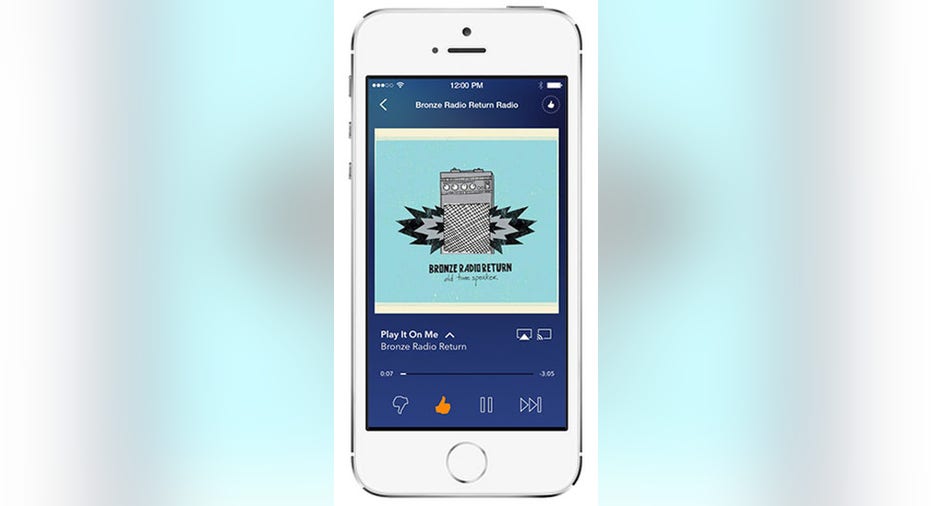Pandora Media's Plan to Compete in On-Demand Streaming

Image source: Getty Images.
Tim Westergren has "no plans" to sell Pandora Media . The Internet radio company has been linked to buyout rumors since February, but the CEO seems more focused on building the next phase of Pandora -- on-demand streaming.
"We're on the path to do something big and something for the long term, so no plans for that," Mr. Westergren told Glassnotes Records founder Daniel Glass at the MIDEM conference over the weekend.
Last year, Pandora bought the assets of bankrupt on-demand streaming service Rdio. While it's unable to take over the contracts Rdio had in place with record labels, it now has the technological infrastructure to launch an on-demand service. But with Spotify and Apple already leading the increasingly crowded market, how does Westergren expect to compete?
Differentiating its product with user data
Pandora has the benefit of an existing audience. It ended the first quarter with 79.4 million active listeners. Only Spotify has a greater number of active listeners with 89 million as of the end of last year, according to its annual report.
What's more, Pandora has been streaming music for a long time -- since 2004. Spotify didn't launch its product until four years later. So despite Spotify's rapid growth in users, Pandora may have a better idea of what its listeners want from a paid service.
Image source: Pandora Media
Tim Westergren told the audience at MIDEM that Pandora has "an audience that's so engaged and about which we know so much, their station history and behavior on the platform, and we're uniquely positioned to look at these people who aren't paying for the service and [figure out] how can we entice them into subscribing to something with more capabilities."
Pandora's current paid subscription offering hasn't attracted many listeners. As of the end of last quarter, Pandora counted just 3.9 million subscribers, less than 5% of its user base. Spotify, comparatively, has 30 million paid subscribers -- about one-third of its user base -- and Apple says it has 13 million subscribers for Apple Music.
But Westergren thinks Pandora's huge base of free listeners could be interested in a less expensive alternative to Spotify or Apple Music. "I think the big challenge is there's a small segment of the population that will pay the $120 per year," he said. "We think there's a much bigger audience that will pay maybe something less for mid-level features."
A mid-level offer is something that's missing from the music streaming market. That's largely due to the pressure record labels put on on-demand streaming services -- requiring upfront fees or minimum guaranteed payouts and dictating minimum pricing for each service (i.e., $10 per month). Pandora has been a thorn in the side of most record labels for some time, so it'll be interesting to see if it can work out something different to offer a mid-priced service.
Is there any potential for profit?
Pandora currently benefits from relatively low royalty rates. Last year, the company paid out just 52% of its revenue to copyright holders and publishers. That climbed to 58% in the first quarter after the new Copyright Royalty Board rate of $0.17 per thousand songs plays kicked in.
Still, that's significantly below the standard 70% payout ratio for streaming services like Spotify and Apple Music. In fact, Spotify ended up paying out almost 84% of its revenue to record labels last year because of the structure of its contracts. So Pandora can expect a big bump in its cost of goods if and when it launches an on-demand service.
That means it will be even more hard-pressed to make a profit. Last quarter, Pandora's net loss widened to $115 million from $48 million the year before. A lot of that loss comes from Pandora's continued investment in its sales team: Sales and marketing expenses increased 40% last quarter to $118 million. Westergren says, "Pandora has a profitable core business" implying that if you took away Pandora's aggressive investments in sales, the company would produce a profit.
If Pandora can leverage that sales team for an on-demand service, capitalizing on one of its biggest strengths, it could produce results significantly better than Spotify. Spotify's free listeners account for just 11% of the company's revenue despite outnumbering paid listeners by more than 2-to-1. Pandora's free listeners generate about $0.85 for every dollar in subscription fees compared to Spotify's $0.15 on the dollar.
Generating more ad revenue per listener would help Pandora meet the guaranteed minimums and other stipulations from record labels, driving down the percentage of revenue paid out for song streams. That makes it more likely that Pandora will be able to make a profit from an ad-supported streaming service.
Funneling those ad-supported listeners into a differentiated product at a price they're willing to pay will be the big challenge for Pandora. If it pulls it off, it could find itself with a profitable business at its "core." It not, at least it only spent $75 million on Rdio.
The article Pandora Media's Plan to Compete in On-Demand Streaming originally appeared on Fool.com.
Adam Levy owns shares of Apple. The Motley Fool owns shares of and recommends Apple and Pandora Media. The Motley Fool has the following options: long January 2018 $90 calls on Apple and short January 2018 $95 calls on Apple. Try any of our Foolish newsletter services free for 30 days. We Fools may not all hold the same opinions, but we all believe that considering a diverse range of insights makes us better investors. The Motley Fool has a disclosure policy.
Copyright 1995 - 2016 The Motley Fool, LLC. All rights reserved. The Motley Fool has a disclosure policy.